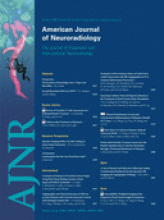Abstract
BACKGROUND AND PURPOSE: CT and MR imaging of the brain have diverged reference lines. Modified Talairach anterior/posterior commissure (ACPC) line is widely accepted as the standard for clinical brain MR imaging, while orbitomeatal line (OML) is used for CT. This study sought to determine an appropriate reference line for brain CT parallel to the ACPC line.
MATERIALS AND METHODS: We measured the angles between the ACPC line and the OML, the line connecting the tuberculum sellae and the internal occipital protuberance (TS-IOP line), and the line connecting the tuberculum sellae and the external occipital protuberance (TS-EOP line) on midsagittal brain MR images of 223 patients. In addition, with the hard palate as the basis, the angles to the ACPC line in the brain MR images and new reference line on the brain CT images from the same patient were measured, and the difference between the 2 angles was calculated in 30 patients. In the same method, the angles to the OML in the brain CT images and the ACPC line on the brain MR images were measured, and their difference was calculated in 30 patients. Then the 2 difference values were compared with verification of the new reference line.
RESULTS: The angles between the ACPC line and both the TS-IOP line (0.0° ± 4.0°) and the TS-EOP line (0.8° ± 3.2°) were significantly smaller than the angles between the ACPC line and the OML (–12.6° ± 4.2°; P < .05). In actual scanned images, the angle differences between the TS-OP (TS-IOP + TS-EOP) line and the ACPC line (0.3° ± 4.5°) were statistically smaller than the angles between the OML and the ACPC line (–6.6° ± 3.9°; P < .05).
CONCLUSIONS: TS-OP lines are nearly parallel to the ACPC line.
- Copyright © American Society of Neuroradiology












